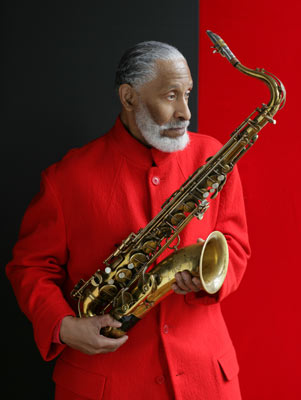Sonny Rollins Brings His Tenor Sax Back to UCSB
Saxophone Colossus Returns to Campbell Hall
New York confuses people with its aesthetic reputation. A lot gets lost in translation. Take, for instance, the history of jazz. The great migration, the Harlem Renaissance, the Cotton Club, Birdland-all familiar, all major, yet all still only parts of a much bigger musical picture. Sonny Rollins may be the most significant performer in American music today because he represents such an enormous chunk of New York City’s extraordinary musical history. Existing as a veritable polyglot, and speaking a language all his own, Rollins is the genius loci of Manhattan music, and has been for more than 50 years. Developing in a music scene that began in the 18th century as a hotbed for European classical and opera, Rollins has known a New York that still always had room for sea chanteys, spirituals, and broadsides to be sung in its streets. Musically inclined people of African descent from all over the Diaspora arrived in New York for generations, including Rollins’s own parents. The great tenor saxophonist, who was the child of emigrants from the U.S. Virgin Islands, was born in Harlem on September 7, 1930-smack in the middle of the Harlem Renaissance : and the Great Depression.

Recently I had a chance to speak with Rollins, who is, at 78, commonly considered “the greatest living improviser.” He also has a new album, titled Road Shows, Volume 1 and will be appearing on Monday, April 27, at Campbell Hall.
What do you remember about the Harlem of your youth? I remember a group of like-minded boys such as Jackie McLean, Kenny Drew, Arthur Taylor, and myself living up there [in Harlem], and growing up with iconic musical figures in our midst. As children, we would see them in their everyday life. I’m talking about Coleman and Erskine Hawkins, Andy Kirk, and of course Duke Ellington. Being a jazz musician at that time was just the thing to be. It looked like a good life in every way. Seeing these elegant men with their beautiful women, and making art-who could resist that?
When did you start going down to the clubs on 52nd St.? As a young teenager, I would put on a moustache with eyebrow pencil to try to look older just so that I could go to Birdland. But you know that the people who ran those clubs weren’t worried about letting underage musicians in. We just hung by the bar and listened, and these men were unscrupulous. We were the least of their worries.
Who did you see at Birdland when you were sporting that eyebrow pencil moustache? Charlie Parker, mostly. By 1944 Bird had broken through. His influence was everywhere. You had to go see him. And the war wasn’t even over.
Tell me about the impact of World War II on your community. I think that the wartime was actually good in the sense that people began to practice thrift. There was rationing for everything. We saved tin foil, along with pork fat, chicken fat-any kind of grease. Even in good times, I think that people benefit from that attitude of thrift. It’s human nature though, because once things get easy, people cease to develop.
What things besides jazz influenced you as a young musician? My mother took me to the Broadway shows, and to Gilbert and Sullivan operettas in Harlem. I saw The Pirates of Penzance when I was very small. It was performed outdoors in Harlem in Colonial Park, and that really impressed me. My older brother studied violin, my older sister sang. My parents were educated, and they wanted us to have that. We spent time at the Light Operetta at City Center. That theater is still there. As a result, my repertoire has always included pieces from the standard American songbook, show tunes, and things from the radio and movies.

You have been recognized for taking tunes from popular music and making them work as jazz. How did that aspect of your music come about? Coleman Hawkins. He started it. “Body and Soul” was a pop song and Hawkins made it a masterpiece-and the best-selling jazz record of the era. It was just a matter of jazz using these melodies to tell its own story. After Coleman Hawkins, the “instrumental version of a pop song” die was cast.
Who will be in the band you are bringing to Santa Barbara? Six people. There will be myself, Clifton Anderson on trombone, Kobe Watkins on drums, Bobby Broom on guitar, Bob Cranshaw-who has been with me on bass for years-and Kimati Dinizulu on percussion.
What can we expect? I really don’t know. Everything I do at this point is a surprise to me. As far as the set lists go, there will be some new material, because I still write and love to write, so there will be some things that haven’t been recorded. But also there will be more familiar stuff; what people know, and the Caribbean will of course be represented. It will be a full evening of all different kinds of music.
4•1•1
Sonny Rollins will appear at UCSB’s Campbell Hall on Monday, April 27, at 8p.m. For tickets and information, call 893-3535 or visit artsandlectures.sa.ucsb.edu.



